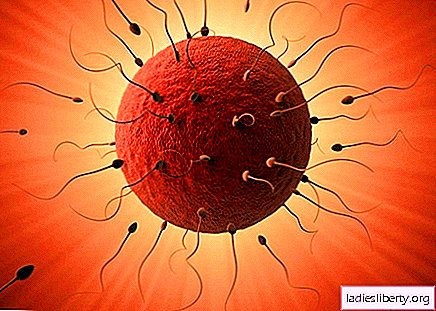
What is fertilization?
Fertilization is the very first stage of the birth of a new life. It begins with the meeting and connection of two germ cells: male and female - the sperm and egg. At the site of their merger, a zygote is formed - a cell that combines a complete set of 46 chromosomes with genetic information obtained from the parent cells. At the stage of fertilization, the gender of the future person has already been determined. He is chosen randomly, like a lottery. It is known that both the egg cell and the sperm cell contain 23 chromosomes, one of which is the sex chromosome. Moreover, the egg can contain only X-sex chromosome, and the spermatozoon - both X and Y-sex chromosome (approximately 50%). If a sperm cell connects with an X-sex chromosome to an egg cell, the child will be female, and the Y chromosome will be male.

How does the process of fertilization
Approximately in the middle of the monthly cycle, a woman ovulates - from the follicle in the ovary, into the abdominal cavity comes a mature egg capable of fertilization. She is immediately picked up by the cilia of the fallopian tubes, which, by cutting, push the egg inside. From this moment on, the woman's body is ready for fertilization, and for about a day a viable egg cell in the fallopian tubes will be waiting for a meeting with the spermatozoon. To make it happen, he will have to go a long, thorny path. Having gotten during intercourse with a portion of seminal fluid in the vagina, almost half a billion spermatozoa, wagging for acceleration by their tails, rush upwards.
Before the cherished meeting you need to walk a distance of about 20 centimeters, which will take several hours. On the way of sperm there will be many obstacles, overcoming which, most of the tails will die. The goal will reach the most hardy sperm. In order for fertilization to take place, no less than 10 million must penetrate into the uterus, which will help pave the way for each other. Only a few thousand will reach the finish, and only one of them will go inside. Not necessarily the strongest, most likely lucky, who will be closest to the mink-entrance, over which all worked to dig, to break through the protective shell of the egg.
As soon as the sperm cell is inside the egg cell, they merge, i.e. fertilization. Now it is not sperm and egg alone, but a single cell is a zygote. Soon it will begin its first division, forming two cells. Then they will be further divided into four, eight cells, etc. Gradually, the dividing cells will turn into an embryo, which the fallopian tubes, pushing, will push towards the uterus. He needs to leave this place as soon as possible, because if it is delayed, implantation will occur directly in the oviduct, which will lead to ectopic pregnancy. Approximately on the fifth or sixth day, the embryo reaches its goal: it enters the uterus, where it will be in free swimming for a couple of days, looking for a place to stick. The implantation of the embryo occurs on average between the seventh and tenth day after fertilization, sometimes a little earlier or later. Having found a convenient place, it will be almost two days, like a gimlet, bite into the lush endometrium in order to firmly consolidate. Plunging deep into, it touches the blood vessels located in the wall of the uterus, so small hemorrhages occur at the site of implantation. At this time, a woman may notice in her minor bleeding, which is called implant bleeding and referred to as the early symptoms of pregnancy. An implanted embryo begins to release into the mother's blood the hCG, a pregnancy hormone, to which pregnancy tests react. Therefore, ten days after ovulation, you can try to dunk the first test. In case of confirmation of pregnancy and its successful development, the embryo will continue its growth and formation, and after 9 months a new person will be born.
Artificial insemination
Artificial insemination helps couples to conceive a long-awaited baby in the case of male or female infertility. Depending on the cause of infertility, this or that method of artificial insemination is prescribed. Pregnancies resulting from any of them are completely natural and do not require further special observation. There are three main methods of artificial insemination:
- AI (artificial insemination);
- IVF (in vitro fertilization);
- ICSI (intracytoplasmic sperm injection).
The easiest and most affordable is artificial insemination. In this procedure, the male seminal fluid is inserted through the catheter directly into the uterus of the woman, then the spermatozoa independently move into the fallopian tubes to meet with the egg, where fertilization takes place naturally. Before the introduction, the sperm is specially prepared: reject weak spermatozoa, leave the most active and mobile, capable of fertilization.
Before an AI, a couple undergoes a medical examination, tests for sexually transmitted infections, a man is given a spermogram (sperm analysis), the woman has a fallopian tube for patency to avoid ectopic pregnancy. Often, for greater efficiency of the procedure, they additionally stimulate ovulation with medical preparations.
Artificial insemination is prescribed for:
- absence of ovulation;
- vaginism, when due to spasms and involuntary contractions of the pubic-coccygeal muscle in a woman, penetration of the penis is extremely difficult;
- cervical factor of infertility, when sperm can not penetrate the uterus and die in the vagina;
- sexual partner disorder and the inability to conduct full sexual intercourse;
- poor sperm analysis;
- infertility in young couples. AI is chosen as the first way to deal with unexplained infertility.
The effectiveness of this method is on average 20-25%. This percentage may be more or less, depending on the age of the couple, the quality of sperm and other factors.
IVF - in vitro fertilization, the procedure is quite lengthy and time consuming. It is prescribed when all methods of treating infertility have been tried, but there are no results. Initially, the couple undergoes a complete physical examination and examination, tests of urine, blood, sexually transmitted infections, hormones, women undergo pelvic ultrasound, test the patency of the fallopian tubes, men make spermogram. Then proceed directly to the IVF procedure. It consists of several stages. Initially, a woman is given overstimulation of the ovaries by injecting with certain hormones into the body so that several full-fledged eggs ready for fertilization are ripe. Then these eggs are removed: under general anesthesia, punctures are made in the lower abdomen from the side of the ovary or under local anesthesia, a needle is inserted through the vagina.
Before fertilization, the selected portion of the male seed is trained: sperm are separated from the seminal fluid, transferred to an incubator and placed in a nutrient medium. Further, the most active and full-fledged sperm (about 100 thousand) in a glass bowl are mixed with oocytes taken from a woman. In a day it will be possible to see if fertilization has occurred. If it is done, the most viable zygotes are selected to grow embryos from them. After another 24 hours, it is possible to determine if the embryo is developing. They are given another 2-3 days to grow up and transplanted with a thin catheter through the vagina into the uterus.
Usually transfer two or three embryos (sometimes more), so that at least one of them will take root. The remaining high-quality germs are frozen and stored at -196C. In the future, if the couple wants to have more children, they will not need to re-fertilize, it will be enough to use ready-made embryos. If the transplant was successful, the embryo took root and implanted in the uterus, then normal pregnancy develops. If menstruation begins in 10-14 days, then the attempt was unsuccessful. The probability of pregnancy by the method of IVF - when two embryos are transplanted is 20%, three - 30%.
In those rare cases when 3 or more embryos are engrafted during the IVF procedure, a woman may be reduced for medical reasons or if she wishes. Extra germs are removed without endangering the rest. Depending on the chosen method of reduction, the procedure is carried out for a period of 5 to 10 weeks of pregnancy.
A few decades ago, conception in a test tube seemed fantastic, now it is a reality.
ICSI is an intraplasmic injection of a spermatozoon. It is prescribed for the male factor of infertility when, for whatever reason, the sperm cell cannot penetrate an egg cell. Most often this happens due to the small number of motile sperm, the absence of sperm in the seminal fluid, teratospermia and other sperm pathologies.
In this procedure, the sperm is inserted into the egg with the aid of a very fine needle. The egg cell is previously removed from the woman's ovary. All manipulations are carried out under a microscope. First, the egg is treated with a special solution to dissolve the outer shell, then the sperm is injected with a needle.
During the ICSI procedure, the couple undergoes the same preparation and examination as in IVF. The difference is that with IVF spermatozoa, are with eggs in a special solution and independently penetrate inside, and with ICSI - one is selected, the most healthy and viable spermatozoon and is placed inside the egg with a needle. The selection of sperm occurs under a very powerful microscope, with a four-fold increase. A variation of the ICSI method is considered to be the IMSI when the sperm is sampled under a more powerful microscope, magnified 6,000 times. The probability of pregnancy with ICSI is approximately 30%.
Comments











